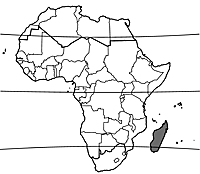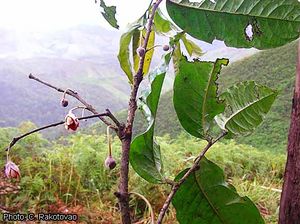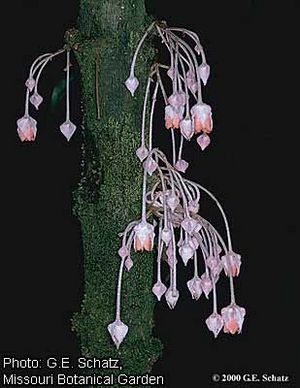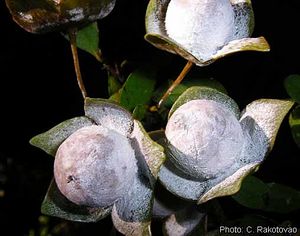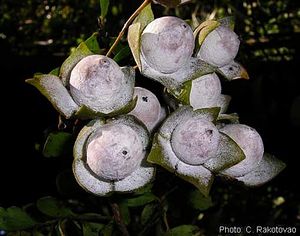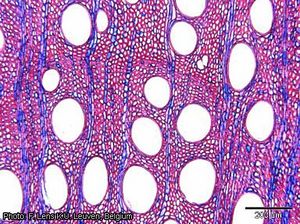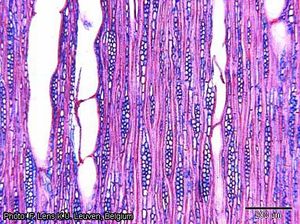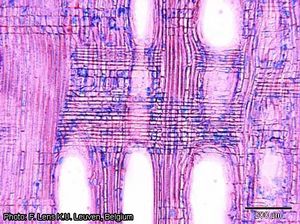Diospyros gracilipes (PROTA)
Introduction |
Diospyros gracilipes Hiern
- Protologue: Monogr. Eben.: 191 (1873).
- Family: Ebenaceae
Vernacular names
- Madagascar ebony (En).
- Ebène de Madagascar (Fr).
Origin and geographic distribution
Diospyros gracilipes is endemic to Madagascar, where it is widespread in the northern and eastern parts of the island.
Uses
The black heartwood, known as ‘hazomainty’, is used for high-quality joinery, furniture, musical instruments, pegs, ornaments, inlay work, handles, carvings and turnery. The bark, leaves and fruits are used in mixtures to stimulate contractions of the uterus during childbirth, and as an abortive. This practice is not without danger; fatal cases have been reported.
Production and international trade
Export of Madagascar ebony started in the 16th century by the Portuguese. Together with rosewood (from Dalbergia spp.), ebony from some Diospyros spp., of which Diospyros gracilipes is one of the most important, is considered the most precious and valuable wood in Madagascar. It fetches extremely high prices, even when traded in smaller dimensions. In recent years, the export of Madagascar ebony, as well as that of rosewood, is nearly entirely to China.
Properties
Distinction between Diospyros spp. of Madagascar producing black ebony is usually not made, and the wood properties are said to be quite similar. The heartwood near the centre and base of old boles is black, sometimes with whitish streaks, and distinctly demarcated from the whitish sapwood which becomes yellowish upon exposure. The grain is usually straight, sometimes wavy to slightly interlocked, texture very fine. The wood is heavy, with a density of 900–1100 kg/m³ at 12% moisture content. It dries rather slowly, with little tendency to distort. It takes about 4 months to air dry boards of 2.5 cm thick. The rates of shrinkage are moderately high, from green to oven dry about 4.5% radial and 9.2% tangential. Once dry, the wood is stable in service. At 12% moisture content, the modulus of rupture is about 190 N/mm², modulus of elasticity 22,700 N/mm², compression parallel to grain 63 N/mm² and Chalais-Meudon side hardness 12.
The wood is fairly easy to saw and work, but needs high-power tools because of its high density, abrasiveness and presence of silica (about 0.1%). It takes a smooth and nice finish without the use of a filler. It has a tendency to split upon nailing and screwing, and pre-boring is recommended. The wood is durable; it is resistant to impregnation with preservatives.
The exudate from the bark may cause black marks and vesicles on the skin.
Description
- Evergreen small tree up to 15 m tall; bole usually low-branching, up to 30(–40) cm in diameter; bark surface smooth to more or less rough, blackish brown, inner bark thin; crown with spreading branches; twigs usually glabrous.
- Leaves alternate, simple and entire; stipules absent; petiole 3–10 mm long; blade elliptical-lanceolate to ovate-lanceolate, (3–)6–12 cm × (1.5–)2–6 cm, cuneate to rounded at base, short-acuminate at apex, wavy at margins, thin-leathery, pinnately veined with 4–7 pairs of lateral veins. Inflorescence an axillary fascicle, often on older branches or on the bole, up to 20-flowered.
- Flowers unisexual, regular; pedicel slender, up to 5 cm long, strongly elongating in fruit; calyx cup-shaped, 3–8 mm long, short-hairy, with tube about as long as the 4 lobes, strongly enlarging in fruit; corolla slightly longer than calyx, with long tube and 4–6 rounded lobes; male flowers with 8–16 stamens, filaments very short; female flowers larger than male ones, with c. 6 rudimentary stamens, ovary superior, ovoid, reddish brown hairy, 8–10-celled, styles 8–10, fused at base.
- Fruit an ovoid to oblong berry c. 3 cm long, brownish green, covered by a whitish powder, up to 8-seeded.
- Seeds elongate, flattened, c. 12 mm long, blackish.
- Seedling with epigeal germination.
Other botanical information
Diospyros gracilipes is variable and some varieties have been distinguished. It grows slowly and tolerates shade. It usually flowers in May–June and September–December and fruits ripen 3–6 months later. Ripe fruits are eaten by lemurs, which may disperse the seeds.
Diospyros is a large pantropical genus of about 500 species; in mainland tropical Africa about 90 species occur and several produce valuable timber or edible fruits. Over 100 species have been recorded for Madagascar, several of which provide valuable ebony wood, and possibly the total number of species is around 200. About 14 species are endemic to the Mascarene islands.
Diospyros perrieri
Diospyros perrieri Jum. is the main producer of ebony wood in western Madagascar; it has black heartwood similar to that of Diospyros gracilipes. However, nearly all larger trees of Diospyros perrieri have disappeared.
Diospyros platycalyx
Diospyros platycalyx Hiern is also reported to provide blackish heartwood, but is also under high pressure caused by exploitation in its distribution area in western Madagascar.
Diospyros tessellaria
Diospyros tessellaria Poiret is as small to medium-sized tree up to 20 m tall, with slender, straight bole, endemic to Mauritius. It provided the ebony of commerce of Mauritius (‘bois d’ébène noir’), but larger trees have nearly all disappeared from the forests.
Ecology
Diospyros gracilipes occurs mainly in humid evergreen forest, from sea-level up to 1350(–1650) m altitude. The mean annual rainfall is (500–)1000–2500(–3000) mm, with 1–7 dry months, and the mean annual temperature is 20–24°C. It occurs on a variety of soils, from sandy to limestone and rocky soils.
Management
The 1000-seed weight is 600–650 g. Germination starts 3–7 weeks after sowing and the germination rate of fresh seed is about 65%. The seeds are extracted from the fruit and usually sown in pots or polythene sacs. Propagation by root suckers is possible. The tree coppices well. Enrichment planting of natural forest with Diospyros gracilipes is sometimes practised.
Genetic resources
Large-scale unauthorized logging of Madagascar ebony occurs in the forests of Madagascar. In 2009 large amounts of ebony trees were logged in Madagascar, together with even larger amounts of rosewood (Dalbergia spp.) trees, and the export was mainly to China. Only small quantities were shipped to Germany and Mauritius.
Several Diospyros spp. in Madagascar are being considered for inclusion in the CITES Appendix II list, including Diospyros gracilipes, Diospyros perrieri and Diospyros platycalyx.
Prospects
Most Diospyros spp. providing valuable black ebony wood in Madagascar and the Mascarene islands are under strong pressure caused by over-exploitation. Sustainable production of this type of timber is unlikely on a commercial basis because the black heartwood is only available in the bole core of old trees; moreover, the trees grow slowly. Enrichment planting might be an option, but will require very long rotation cycles. Because of the high value of the wood, studies on optimal management could be useful, but for the time being protection measures are needed.
Major references
- Blaser, J., Rajoelison, G., Tsiza, G., Rajemison, M., Rabevohitra, R., Randrianjafy, H., Razafindrianilana, N., Rakotovao, G. & Comtet, S., 1993. Choix des essences pour la sylviculture à Madagascar. Akon’ny Ala: Bulletin du Département des Eaux et Forêts 12–13. 166 pp.
- Debray, M., Jacquemin, H. & Razafindrambao, R., 1971. Contribution à l’inventaire des plantes médicinales de Madagascar. Travaux et Documents No 8. ORSTOM, Paris, France. 150 pp.
- Normand, D., Sallenave, P. & Rothe, P.L., 1960. Les ébènes dans le monde. Bois et Forêts des Tropiques 72: 15–22.
- Perrier de la Bâthie, H., 1952. Ebénacées (Ebenaceae). Flore de Madagascar et des Comores (plantes vasculaires), famille 165. Firmin-Didot et cie., Paris, France. 137 pp.
- Rakotovao, G., Rabevohitra, R., Gerard, J., Détienne, P. & Collas de Chatelperron, P., en préparation. Atlas des bois de Madagascar. FOFIFA-DRFP, Antananarivo, Madagascar.
Other references
- Ballet, J., Lopez, P. & Rahaga, N., 2010. L’exportation de bois précieux (Dalbergia et Diospyros) <<ill>> de Madagascar: 2009 et après? Madagasacar Conservation & Development 5(2): 110–116.
- Innes, J.L., 2010. Madagascar rosewood, illegal logging and the tropical timber trade. Madagasacar Conservation & Development 5(1): 6–10.
- Richardson, I.B.K., 1981. Ebénacées. In: Bosser, J., Cadet, T., Guého, J. & Marais, W. (Editors). Flore des Mascareignes. Familles 111–120. The Sugar Industry Research Institute, Mauritius, l’Office de la Recherche Scientifique Outre-Mer, Paris, France & Royal Botanic Gardens, Kew, Richmond, United Kingdom. 19 pp.
- Schuurman, D. & Lowry, P.P., 2009. The Madagascar rosewood massacre. Madagascar Conservation & Development 4(2): 98–102.</ill>
Author(s)
- R.H.M.J. Lemmens, PROTA Network Office Europe, Wageningen University, P.O. Box 341, 6700 AH Wageningen, Netherlands
- D. Louppe, CIRAD, Département Environnements et Sociétés, Cirad es-dir, Campus international de Baillarguet, TA C 105 / D (Bât. C, Bur. 113), 34398 Montpellier Cédex 5, France
Correct citation of this article
Lemmens, R.H.M.J. & Louppe, D., 2011. Diospyros gracilipes Hiern. [Internet] Record from PROTA4U. Lemmens, R.H.M.J., Louppe, D. & Oteng-Amoako, A.A. (Editors). PROTA (Plant Resources of Tropical Africa / Ressources végétales de l’Afrique tropicale), Wageningen, Netherlands.
Accessed 22 December 2024.
- See the Prota4U database.

